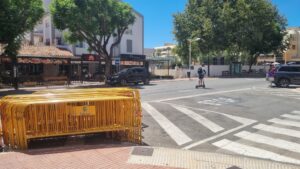Valencia prepares vaccination points to immunize almost 4 million people
Xàbia will be one of the established vaccination points in the Marina Alta, along with Dénia, Calp, Benissa, Teulada, Pedreguer, Ondara, Pego, El Verger and Orba.
Wednesday 3rd March 2021 | MIKE SMITH
The regional Ministry of Health is preparing all health departments to coordinate the mass vaccination process that begins in April. To this end, an action protocol has been sent to the departments’ management in which the conditions that must be met are explained, both the spaces that will house the vaccination circuits, as well as the care criteria regarding the specific vaccination teams and preparing the necessary materials to carry it out.
In this sense, the forecast is to carry out an average of 400,000 vaccinations every week in the Comunidad Valenciana. For this, three types of demarcations have been established to regroup the municipalities according to the number of population and taking into account the number of sessions that each specific vaccination team has to carry out to reach the entire target population.
Thus, municipalities with less than 10,000 inhabitants will have a vaccination point located next to a health centre or municipal premises. In municipalities with 10,000 to 50,000 inhabitants, the location will be in municipal premises defined by the health department. And finally, for those municipalities with more than 50,000 inhabitants, it is planned to establish mass vaccination in field hospitals and in other spaces defined by the Ministry of Health, such as the Ciudad de las Artes y las Ciencias de València, the Ciudad de la Luz de Alicante, the Institución Ferial Alicantina (IFA) de Elche and the Auditorio y Palacio de Congresos de Castelló de la Plana.
In addition, vaccination spaces must be located as close as possible to population centres and must be accessible by private vehicles and public transport, as well as meeting the appropriate conditions to establish entry and exit circuits.
It should be noted that the Ministry of Health has established a protocol taking into account the need to carry out an effective, agile and equitable vaccination process. And in turn, the need to continue with the usual health care in health centres is taken into account. For this reason, in health centres the vulnerable population is vaccinated, and for the general population, these specific vaccination spaces have been established.
Professional teams for mass vaccination
Another of the criteria contemplated in the protocol is the provision of human resources to be able to carry out mass vaccination, for which specific vaccination teams will be created, which will coordinate the entire vaccination process from the arrival of the patient until it is vaccinated.
Said teams will be made up of two nurses, an administrator, medical staff, nursing assistants, as well as orderlies and security personnel.
In addition, differentiated areas will be established at the vaccination points, enabling a unidirectional circuit in order to maintain the safety distance and establish preventive measures, from the time the patient arrives until they go to the post-vaccination room where they must remain at least 15 minutes for any adverse reaction.
In short, the entire vaccination process has been designed in order to administer the vaccines to the largest number of the indicated population, and in the shortest possible time.
Established vaccination points
161 different vaccination points have been established throughout the entire Comunidad Valenciana, depending on the population that will receive the vaccine in each one of them. In total, there are 3,915,482 people between 18 and 80 years old, with the exception of groups that have already received the vaccine (such as health workers, emergency personnel, etc). These are the municipalities that will have a vaccination point. The rest will be assigned a vaccination point in nearby towns.
Less than 50,000 inhabitants: Morella, Peñíscola, Traiguera, Alcalà de Xivert, Benicarló, Vinarós, Cabanes, Albocàsser, Vall d’Alba, Oropesa del Mar, L’Alcora, Benicasim, El Grao de Castellón, Almassora, Montanejos, Betxí, Nules , Onda, La Vall d’Uixó, Burriana, El Puig de Santa María, Faura, Estivella, Almenara, Puçol, Segorbe, Rafelbunyol, Tavernes Blanques, Meliana, Almàssera, Museros, Foios, Alboraya, Massamagrell, Ademuz, Rocafort, Chelva, Benaguasil, Vilamarxant, Godella, La Pobla de Vallbona, Moncada, L’Eliana, Bétera, Lliria, Burjassot, Massanassa, Alcàsser, Albal, Silla, Catarroja, Ayora, Utiel, Requena, Picanya, Montserrat, Picassent, Paiporta, Alaquàs, Xirivella , Sedaví, Benetússer, Alfafar, Benifaió, Almussafes, Alginet, Alberic, L’Alcúdia, Carcaixent, Carlet, Cullera, Algemesí, Sueca, Alzira, Castelló de Rugat, Vilallonga, Grau de Gandia, Tavernes de La Valldigna, Oliva, Bellreguard, Orba, El Verger, Pedreguer, Ondara, Pego, Teulada, Benissa, Calp, Jávea/Xàbia, Dénia, Moixent, La Pobla Llarga, Albaida, L’Olleria, Benigànim, Castellón, Chella, Canals, Xàtiva, Ontinyent, Banyeres de Mariola, Onil, Castalla, Cocentaina, Muro de Alcoy, Ibi, Callosa d’En Sarrià, L’Alfàs del Pi, La Nucía, Altea, Villajoyosa, Jijona, Sant Joan d’Alacant, Mutxamel, El Campello, Biar, Pinoso, Sax, Monóvar, Novelda, Villena, Monforte del Cid, Santa Pola, Dolores, Catral, Bigastro, Albatera, Almoradí, Callosa de Segura, San Miguel de Salinas, Pilar de La Horadada, Guardamar del Segura, Rojales, Cheste, Turís, Chiva, Buñol, Riba-Roja de Turia, Quart de Poblet, Manises, Aldaia, Mislata, Aspe and Crevillent.
More than 50,000 inhabitants: Vila-real, Sagunto, Puerto de Sagunto, Paterna, Torrent, Gandia, Alcoy, Benidorm, Petrer, Elda, San Vicente del Raspeig, Orihuela and Torrevieja.
Large vaccination centres: Castelló de La Plana, València, Alicante and Elche.
Information Source
Press Release – Generalitat Valenciana



